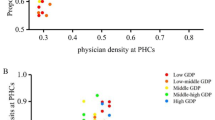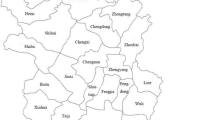Abstract
Objective
In recent years, the co-existence in Germany of two parallel comprehensive insurance systems—statutory health insurance (SHI) and private health insurance (PHI)—has been posited as a possible cause of a persistent unequal regional distribution of physicians. The present study investigates the effect of the proportion of privately insured patients on the density of SHI-licensed physicians, while controlling for regional variations in the average income from SHI patients.
Methods
The proportion of residents in a district with private health insurance is estimated using complete administrative data from the SHI system and the German population census. Missing values are estimated using multiple imputation techniques. All models control for the estimated average income ambulatory physicians generate from treating SHI insured patients and a well-defined set of covariates on the level of districts in Germany in 2010.
Results
Our results show that every percentage change in the proportion of residents with private health insurance is associated with increases of 2.1 and 1.3 % in the density of specialists and GPs respectively. Higher SHI income in rural areas does not compensate for this effect.
Conclusion
From a financial perspective, it is rational for a physician to locate a new practice in a district with a high proportion of privately insured patients. From the perspective of patients in the SHI system, the incentive effects of PHI presumably contribute to a concentration of health care services in wealthy and urban areas. To date, the needs-based planning mechanism has been unable to address this imbalance.



Similar content being viewed by others
Notes
In addition, the regional ASHIPs may deviate from the federal guidelines if this can be justified by, for example, special social or health care population needs or geographical accessibility. However, to date this exemption clause has not been used extensively.
References
OECD: regional access to health. In: OECD Regions at a Glance 2013. OECD Publishing, 124f. http://dx.doi.org/10.1787/reg_glance-2013-39-en (2013). Accessed 05 Nov 2014
Ozegowski, S., Sundmacher, L.: Is the needs-based planning mechanism effectively needs-based? An analysis of the regional distribution of outpatient care providers. Gesundheitswesen 74(10), 618–626 (2012)
Dussault, G., Franceschini, M.C.: Not enough there, too many here: understanding geographical imbalances in the distribution of the health workforce. Hum. Resour. Health 4, 12 (2006)
Dieleman, M., Kane, S., Zwanikken, P., Gerretsen, B.: Realist review and synthesis of retention studies for health workers in rural and remote areas. Technical Report No 1, World Health Organization, Geneva (2011)
Daniels, Z.M., VanLeit, B.J., Skipper, B.J., Sanders, M.L., Rhyne, R.L.: Factors in recruiting and retaining health professionals for rural practice. J. Rural Health 23(1), 62–71 (2007)
Hegney, D., McCarthy, A., Rogers-Clark, C., Gorman, D.: Retaining rural and remote area nurses: the Queensland, Australia experience. J. Nurs. Adm. 32(3), 128–135 (2002)
Hancock, C., Steinbach, A., Nesbitt, T.S., Adler, S.R., Auerswald, C.L.: Why doctors choose small towns: a developmental model of rural physician recruitment and retention. Soc. Sci. Med. 69, 1368–1376 (2009)
Pathman, D.E., Konrad, T.R., Agnew, C.R.: Studying the retention of rural physicians. J. Rural Health. 10(3), 183–192 (1999)
Han, G.S., Humphreys, J.S.: Integration and retention of international medical graduates in rural communities. J. Sociol. 42(2), 189–207 (2006)
Watson, C.: The relationship between physician practice location and medical school area: an empirical model. Soc. Sci. Med. 14, 61–69 (1980)
Mayo, E., Matthews, M.: Spousal perspectives on factors influencing recruitment and retention of rural family physicians. Can. J. Rural Med. 11(4), 271–276 (2006)
Kazanjian, A., Paglicca, N.: Key factors in physicians choice of practice location: findings from a survey of practitioners and their spouses. Health Place 2, 27–34 (1996)
Szafran, O., Crutcher, R.A., Chayrors, R.G.: Location of family medicine graduates practice—what factors influence Albertans choice? Can. Fam. Physicians 42, 2279–2285 (2001)
Pathman, D.E., Konrad, T.R., Dann, R., Koch, G.: Retention of primary care physicians in rural health professional shortage areas. Am. J. Public Health 94(10), 1723–1729 (2004)
Rabinowitz, H.K., Diamond, J.J., Hojat, M., Hazelwood, C.E.: Demographic, educational and economic factors related to recruitment and retentions of physicians in rural Pennsylvania. J. Rural Health 15(2), 212–216 (1999)
Fruen, M.A., Hadley, J., Korper, S.P.: Effects of financial incentives on physicians specialty on location decision. Health Policy Educ. 1, 143–159 (1980)
Scott, A., Witt, J., Humphreys, J., Joyce, C., Kalb, G., Jeon, S.H., McGrail, M.: Getting doctors into the bush: general Practitioners preferences for rural location. Soc. Sci. Med. 96, 33–44 (2013)
Barninghausen, T., Bloom, D.: Financial incentives for return of services in underserved areas: a systematic review. BMC Health Serv. Res. 9, 86 (2009)
Kolstad, J.R.: How to make rural jobs more attractive to health workers. Findings from a discrete choice experiment in Tanzania. Health Econ. 20, 196–211 (2011)
Ubach, C., Scott, A., French, F., Awramenko, M., Needham, G.: What do hospital consultants value about their jobs? A discrete choice experiment. Br. Med. J. 326, 1432 (2003)
Günther, O.H., Kürstein, B., Riedel-Heller, S.G., König, H.H.: The role of monetary and nonmonetary incentives on the choice of practice establishment: a stated preference study of young physicians in Germany. Health Serv. Res. 45, 212–229 (2010)
Gächter, M., Schwazer, P., Theurl, E., Winner, H.: Physician density in a two-tiered health care system. Health Policy 106, 257–268 (2012)
Meliala, A., Hort, K., Trisnantoro, L.: Adressing the unequal geographic distribution of specialist doctors in Indonesia: the role of the private sector and effectiveness of current regulations. Soc. Sci. Med. 82, 30–34 (2013)
Klose, J., Rehbein, I.: Ärzteatlas 2011. Daten zur Versorgungsdichte von Vertragsärzten. AOK Bundesverband, Berlin (2011)
Walendzik, A., Manouguian, M., Greß, S., Wasem, J.: Vergütungsunterschiede im ambulanten ärztlichen Bereich zwischen PK und GKV und Modelle der Vergütungsangleichung. Sozialer Fortschritt. 58, 63–69 (2009)
Destatis: Kostenstruktur bei Arzt- und Zahnarztpraxen sowie Praxen von psychologischen Psychotherapeuten 2011. Series 2 No. 1.6.1. Federal Statistics Office, Wiesbaden (2013)
Regionaldatenbank Deutschland: Beschäftigte des Bundes, der Länder, Gemeinden und Gemeindeverbände. Statistische Ämter des Bundes und der Länder. http://www.regionalstatistik.de (2014). Accessed 26 Oct 2014
Regionaldatenbank Deutschland: Verfügbares Einkommen der privaten Haushalte einschließlich privater Organisationen ohne Erwerbszweck. Statistische Ämter des Bundes und der Länder. http://www.regionalstatistik.de (2014). Accessed 26 Oct 2014
Little, R.J.A., Rubin, D.B.: Statistical analysis with missing data, 2nd edn. Wiley, New York (2002)
Allison, P.D.: Missing data. Sage, Thousand Oaks (2001)
StataCorp 2013 Stata: Release 13. Statistical Software. College Station, TX: StataCorp LP (2013)
Rubin, D.B.: Multiple imputation for nonresponse in surveys. Wiley, New York (1987)
Yett, D.C., Sloan, F.A.: Migration patterns of recent medical graduates. Inquiry 11, 125–142 (1974)
Kluge, J.: Der Traum von gleichwertigen Lebensverhältnissen. ifo Dresden berichtet 19(05), 05–17 (2012)
Wasem, J., Buchner, F., Lux, G., Weegen, L., Walendzik, A.: Ambulante ärztliche Vergütung in einem einheitlichen Versicherungssystem. Kompensation ärztlicher Einkommensverluste? Nomos Verlag (2013)
Author information
Authors and Affiliations
Corresponding author
Rights and permissions
About this article
Cite this article
Sundmacher, L., Ozegowski, S. Regional distribution of physicians: the role of comprehensive private health insurance in Germany. Eur J Health Econ 17, 443–451 (2016). https://doi.org/10.1007/s10198-015-0691-z
Received:
Accepted:
Published:
Issue Date:
DOI: https://doi.org/10.1007/s10198-015-0691-z
Keywords
- Germany
- Private health insurance
- Statutory health insurance
- Physician density
- Regional variation
- Needs-based planning
- Physician income




